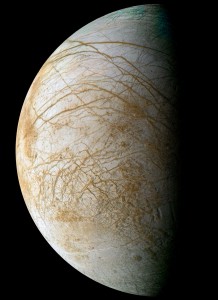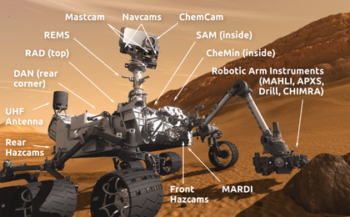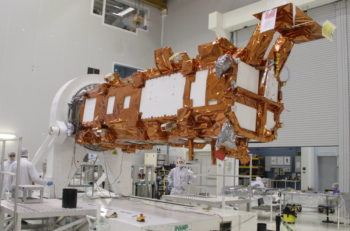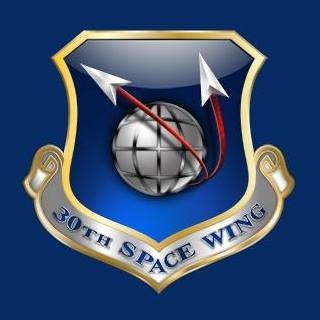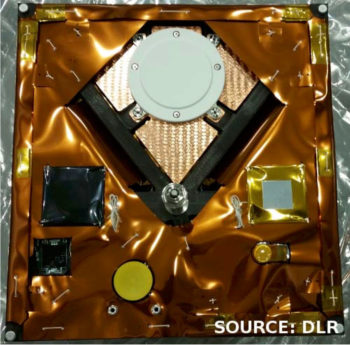Author Archive

Illustration of the seven planets orbiting the TRAPPIST-1 ultra-cool low mass star. Planets e, f, and g orbit in the suspected habitable zone (green) based on the spectral type and modeling of the system. Note: the size of the planets is greatly exaggerated compared to their orbital
radii and that the radial dimension of the TRAPPIST-1 system has been enlarged by a factor of 25. In
other words, the entire TRAPPIST-1 system would fit well inside the orbit of Mercury.
SOURCE: NASA/JPL-Caltech
A new report issued today has recommended that NASA should support research on a broader range of biosignatures and environments, and incorporate the field of astrobiology into all stages of future exploratory missions.
“An Astrobiology Strategy for the Search for Life in the Universe” is a Congressionally mandated report from the National Academies of Sciences, Engineering, and Medicine.

Europan environments that may harbor life or preserve biosignature. A variety of geologic and geophysical processes, including ocean currents governed by tides, rotation, and heat exchange, are required to drive water from the subsurface to the surface and govern how any exchange operates.
SOURCE: Kevin Hand, Jet Propulsion Laboratory, “On the Habitability of Ocean Worlds,” presentation
to the Workshop on Searching for Life across Space and Time, December 5, 2016.
Novel biosignatures
The blue-ribbon committee found that the lines of evidence now used to look for current and past life on Earth and beyond, called biosignatures, needs expansion.
Also, recommended is investigating novel “agnostic” biosignatures – signs of life that are not tied to a particular metabolism or molecular “blueprint,” or other characteristics of life as we currently know it.

Chemical evidence consistent with serpentinization and water-rock interactions on Enceladus and known hydrothermal activity make Enceladus a key target for astrobiology exploration.
Sampling the moon’s plumes would help to establish if life exists there now.
SOURCE: NASA/JPLCaltech/
Southwest Research Institute
Diversity of life
The report explains that NASA should focus on research and exploration of possible life below the surface of a planet in light of recent advances that have demonstrated the breadth and diversity of life below Earth’s surface, the nature of fluids beneath the surface of Mars, and the likelihood of life-sustaining geological processes in planets and moons with subsurface oceans.
A renewed focus on how to seek signs of subsurface life will inform astrobiology investigations of other rocky planets or moons, ocean or icy worlds, and beyond to exoplanets.
Life detection technologies
The report emphasizes the need for NASA to ramp up efforts in developing mission-ready life detection technologies to advance the search for life. Highlighted is implementing technologies in near-term ground- and space-based direct imaging missions that can suppress the light from stars.
Flagged in the NASA-sponsored report is, so far, planning, implementation, and operations of planetary exploration missions with astrobiological objectives have tended to be more strongly defined by geological perspectives than by astrobiology-focused strategies.

Artist rendition of CubeSats at Europa. These twin CubeSats are currently in a feasibility
study to be included with the NASA Europa Clipper mission.
SOURCE: NASA/JPL
Private-sector space missions
Within its nearly 200 pages, the report notes that the burgeoning space economy and possibility of private-sector robotic and human missions to Mars pose challenges to compliance with articles VI and IX of the Outer Space Treaty.
“These challenges are complicated by the absence of a regulatory body in the U.S. with authority to authorize and supervise private-sector activities beyond low-Earth orbit,” the report states.
Planetary protection issues
The recent transfer of NASA’s Office of Planetary Protection (OPP) from the Science Mission Directorate to the Office of Safety and Mission Assurance is generally regarded as a positive change, the report adds.
“However, the move has had some negative consequences,” the report observes. The disestablishment of the Planetary Protection Subcommittee of the NASA Advisory Council has deprived the OPP of its primary internal source of independent scientific and technical advice. “Further, the long-term future of the Planetary Protection research and analysis program, long underfunded and offered only intermittently in recent years, remains unclear.”
The report — “An Astrobiology Strategy for the Search for Life in the Universe” – is available at:
https://www.nap.edu/catalog/25252/an-astrobiology-strategy-for-the-search-for-life-in-the-universe

Curiosity acquired this image using its Mars Hand Lens Imager (MAHLI), located on the turret at the end of the rover’s robotic arm, on November 15, 2014, Sol 809.
Credit: NASA/JPL-Caltech/MSSS
NASA’s Curiosity rover is now in Sol 2196. Due to a rover glitch – still being worked on by engineers – no images have been relayed back to Earth since Sol 2172 on September 15th – nearly a month.
“As Curiosity continues to mend, I’ve been looking forward to our next drill sample of gray rock,” Fraeman reports. “Some interesting features we’ve seen on Vera Rubin Ridge are small ‘swallowtail crystals’ often associated with the boundary between gray and red rocks on the ridge top.”
Geologic clues
Fraeman has been thinking about these features, and reflecting on past results from Curiosity when the robot was just beginning to explore Mt. Sharp at the Pahrump Hills region. Back on sol 809, after the robot brushed away the dust on target “Mojave,” the team was surprised and excited to discover hundreds of millimeter-sized, rice-shaped crystals on its face.
“These crystals are geologic clues to what happened in the past,” Fraeman points out. “What were these unique features made of? How and when did they form?”

Swallowtail crystals close to drill attempt at “Inverness.” This image was taken by Chemistry and Camera (ChemCam) Remote Micro-Imager onboard NASA’s Mars rover Curiosity on Sol 2163, September 6, 2018.
Credit: NASA/JPL-Caltech/LANL
New paper
Curiosity scientist Linda Kah and colleagues address these questions in a new paper available in the journal Terra Nova titled “Syndepositional precipitation of calcium sulfate in Gale Crater, Mars.”
That paper can be found here at:
https://onlinelibrary.wiley.com/doi/full/10.1111/ter.12359
Sizes, shapes, orientations
For this study, Kah and colleagues carefully studied the sizes, shapes, and orientations of the unusual crystals at Mojave and several nearby targets. They integrated these findings with the geologic setting, chemistry, and mineralogy of the Pahrump Hills area to infer the presence of shallow, salty, and sometimes ephemeral waters during this period in Gale’s history.
Kah and co-authors explain that the crystal shapes are distinctive of gypsum salts that precipitate in lake, playa, and near-shore ocean environments.
“Interestingly, Curiosity did not detect any large differences in the composition of rocks containing crystals versus nearby, non-crystal-containing rocks,” Fraeman notes. “This result suggests the calcium sulfate that originally formed the crystals had either been dissolved at a later time and/or that the crystals had incorporated a lot of the original rocks around within them when they formed.”
The shapes, sizes, and orientation of crystals give clues to how they grow.
Swallowtail crystals
Kah and co-authors showed the crystals at Pahrump were randomly oriented and occurred between and within cemented layers.
“Combined with the crystals’ elongated shapes, this suggests that they grew at the interface between loose, water-logged sediment and either shallow water or air,” Fraeman says. “Interestingly, small amounts of organic (carbon-bearing) material can cause crystals to have shapes similar to those observed at Mojave, which is consistent with Curiosity findings of organic material in the Mojave drill sample.”
In conclusion, Fraeman says that the swallowtail crystals on Vera Rubin Ridge are also known shapes of gypsum crystals. “Why are these crystals so different in form from what we saw back at Mojave? What does this all tell us about ancient environments at Gale Crater?”
Just how lonely are we in the universe…or how crowded is it?
Astrobiology, the study of the origins of life in the universe and the search for life on other worlds, is a highly interdisciplinary quest.

Narrow jets of gas and icy particles erupt from the south polar region of Enceladus, contributing to the moon’s giant plume. A cycle of activity in these small-scale jets may be periodically lofting extra particles into space, causing the overall plume to brighten dramatically.
Credits: NASA/JPL/Space Science Institute
It’s a rapidly changing field at the intersection of biology, chemistry, geology, planetary science, and physics.
Recent scientific advances have opened new doors for astrobiological inquiry and at the request of NASA and Congress, the National Academies of Sciences, Engineering, and Medicine (NASEM) appointed a committee to develop a future research strategy for the field of astrobiology.
Briefing event
Wed, October 10, 2018
11:00 AM – 12:00 PM EDT
To join in on this public briefing event and webcast in which committee chair Barbara Sherwood Lollar and committee member Alan Boss will discuss the report’s recommendations and take questions from the audience.
The strategy will outline scientific questions, challenges, and opportunities in the search for signs of extraterrestrial life both within and outside the Solar System. This new strategy updates a previous strategy released in 2015.
Combined with the Exoplanet Science Strategy the National Academies released last month, the astrobiology strategy will inform the upcoming astronomy and astrophysics decadal survey and, ultimately, the planning of future NASA science missions.
Go to:
The hardest thing about living on Mars… is us.
National Geographic’s Mars (Season 2) starts on November 12th.
Go to this new video trailer at:

Artist’s impression of the BepiColombo spacecraft in cruise configuration, with Mercury in the background. The Mercury Transfer Module is shown with ion thrusters firing, and with its solar wings extended. The solar array of the Mercury Planetary Orbiter in the middle is seen extending to the top. The Mercury Magnetospheric Orbiter is hidden inside the sunshield in this orientation.
Credit: ESA/ATG medialab; Mercury: NASA/JPL
The European Space Agency’s BepiColombo mission to Mercury is scheduled to launch aboard an Ariane 5 from Europe’s Spaceport in Kourou, French Guiana on October 20.
BepiColombo is a joint endeavor between ESA and the Japan Aerospace Exploration Agency, JAXA. It’s an ambitious seven-year flight as the mission will make one flyby of Earth, two at Venus, and six at Mercury, before entering orbit.
Two orbiters
The mission comprises two science orbiters: ESA’s Mercury Planetary Orbiter (MPO, or ‘Bepi’) and JAXA’s Mercury Magnetospheric Orbiter (MMO, or ‘Mio’). Once at Mercury, the two orbiters will operate from different orbits to provide the most detailed study of the innermost planet date, from its interior to surface features, to its interaction with the solar wind.

The BepiColombo spacecraft ‘stack’ is complete. ESA’s Mercury Transfer Module sits at the bottom, its two arrays folded for launch. It will use a combination of solar electric propulsion, chemical propulsion, and nine gravity assist flybys over seven years to deliver the two science orbiters to Mercury. On top is JAXA’s eight-sided Mercury Magnetospheric Orbiter. The sunshield that will protect the module during the cruise phase will be added about a week before launch.
Credit: ESA–B.Guillaume
The ESA-built Mercury Transfer Module (MTM) will carry the orbiters to Mercury using a combination of solar electric propulsion and gravity assist flybys.
Cruise phase science
BepiColombo is the first European mission to Mercury, the smallest and least explored planet in the inner Solar System.
The orbiters will be able to operate some of their instruments during the cruise phase, affording unique opportunities to collect scientifically valuable data at Venus, for example.
BepiColombo builds upon the discoveries and questions raised by NASA’s Messenger mission, which orbited the planet between 2011 and 2015, to provide the best understanding of the Solar System’s innermost planet to date.
NASA’s Curiosity Mars rover is now in Sol 2193.
The last images from the Mars machinery reached Earth back on Sol 2172, September 15th.
Engineers continue to wrestle with a glitch that prevents Curiosity from sending science and engineering data stored in its memory.
According to the Jet Propulsion Laboratory, the robot remains in its normal mode “and is otherwise healthy and responsive,” reported Ashwin Vasavada, the Mars Science Laboratory’s project scientist at JPL back on September 19th.
Geological crime scene
Meanwhile, in a new geological update from Susanne Schwenzer, a planetary geologist at The Open University in the United Kingdom: “Geology…it’s like investigating a crime scene.”
“Sometimes planetary geology is like forensics,” Schwenzer says. “We are presented with a crime scene: Something broke down the original igneous rock, and made all those clays, veins and hematite nodules. We know this something was a fluid, but in order to find out exactly what has happened, we need to examine all the evidence we have.”

This view from the Mars Hand Lens Imager (MAHLI) on the arm of NASA’s Curiosity Mars rover shows a combination of dark and light material within a mineral vein at a site called “Garden City” on lower Mount Sharp. The image was taken on April 4, 2015, and covers an area roughly 1 inch wide.
Credit: NASA/JPL-Caltech/MSSS
That often starts with investigating the Curiosity images, and in great detail. Mastcam images for the geologic context, then Remote Micro Imager (RMI) photos and/or the Mars Hand Lens Imager (MAHLI) for the close-up details. But what about the chemistry?
Minerals with water
“We are a small team here in the UK, specializing in what is called “thermochemical modelling.” Thermochemical modelling uses mathematical equations that are based on known reactions of minerals with water,” Schwenzer explains. “The models combine many thousands of such reactions into equations, which can be solved iteratively to arrive at a reaction path for a known rock composition. And once we determine what reacted and how, we can also infer which chemical elements remained in the water because they were not included in the reaction products.”
In other words, Schwenzer adds, scientists can find out how the chemical elements are distributed between the fluid and the newly forming minerals. “Some of our French and American colleagues use this method too, and we always have great discussions to advance our work.”
Clays and veins
All the data — images and chemistry from Chemistry and Camera (ChemCam) and the Alpha Particle X-Ray Spectrometer (APXS) – is studied, and where available also mineralogy from the rover’s Chemistry & Mineralogy X-Ray Diffraction/X-Ray Fluorescence Instrument (CheMin).
“That’s the evidence at our crime scene,” Schwenzer adds. “But who broke the rock and left all those clays and white veins?”
We know it is “the fluid,” and the modelling allows us to find out what temperature and composition this fluid might have had, Schwenzer points out. “For example, we have looked at the veins Curiosity found very early in the mission – at Yellowknife Bay. They were very pure calcium-sulfate, especially compared to what Curiosity measured later at Garden City and now at Vera Rubin Ridge.”
A clue
The purity of the calcium-sulfate at Yellowknife Bay provided a clue:
“If we model a typical Yellowknife Bay rock with all chemical elements in the proportions available in this rock to react with water, then we will get veins that have more than just calcium-sulfate. We would therefore expect veins that have other minerals such as iron oxides and quartz,” Schwenzer reports.
But the veins at Yellowknife Bay did not have any of those additional minerals.
“Therefore, we concluded that they must have come from water selectively dissolving a pre-existing mixed-mineralogy layer,” Schwenzer says. “The dissolution of this pre-existing layer would have left the less soluble minerals – quartz, iron oxides – behind while transporting the calcium and sulfate. This would have allowed the formation of a very pure calcium-sulfate, which is what was observed! But how does that help us at Vera Rubin Ridge?”
Ongoing investigation
Curiosity is positioned now to investigate a very complex area, which has clearly seen the interaction of rocks with fluids.
“There are veins much more complex than the ones at Yellowknife Bay, and in addition there are iron nodules, crystal moulds and color changes,” Schwenzer notes. “We, the modellers, are working hard to understand how the fluid changed to produce all this new evidence… more later, as investigators rarely talk about ongoing investigations, right?”
A SpaceX Falcon 9 rocket carrying the SAOCOM 1A satellite from California’s Vandenberg Air Force Base’s Space Launch Complex-4 is scheduled for Sunday, Oct. 7, at 7:21 p.m. Pacific Daylight Time.
SpaceX is attempting the secondary mission of landing the first stage of the Falcon 9 rocket at Landing Zone 4, which was previously called SLC-4W, at Vandenberg Air Force Base. This will be SpaceX’s first land landing attempt at Vandenberg Air Force Base.
SAOCOM (Satélite Argentino de Observación COn Microondas) is a spacecraft of the Argentine Space Agency, CONAE. This Argentine Microwaves Observation Satellite is the first of a planned Earth observation satellite constellation.
Boom town
As for the Falcon 9 booster stage come back at Landing Zone 4:
“Local residents may see the first stage of the Falcon 9 returning to Vandenberg AFB, including multiple engine burns associated with the landing,” according to 30th Space Wing Public Affairs.
“During the landing attempt residents from Santa Barbara, Ventura and San Luis Obispo counties may hear one or more sonic booms. A sonic boom is the sound associated with the shock waves from an aircraft or vehicle traveling faster than the speed of sound. Sonic booms generate a sound similar to an explosion or a clap of thunder. The sonic boom experienced will depend on weather conditions and other factors.”

Image of MASCOT photographed with the optical navigation camera (ONC-W1), taken 2 minutes and 20 seconds after the lander separated from the spacecraft. The ONC-W1 is attached to the bottom of the spacecraft, so the view is directly below Hayabusa2. At this point, the spacecraft is rising slowly. MASCOT is the white dot and has not yet landed on the asteroid surface, so the lander casts a shadow that creates a black dot on the surface of Ryugu. Beside it is the shadow of Hayabusa2. If you enlarge the white dot of MASCOT it appears as if there is a white round dot inside a black square. It seems that it is the base (bottom) of MASCOT that is visible. The shining white dot is thought to be the antenna.
Credit: JAXA, University of Tokyo & collaborators
Japan’s Hayabusa2 successfully deployed the Mobile Asteroid Surface Scout (MASCOT), a lander developed in Germany and France.
The small asteroid lander separated from the Hayabusa2 spacecraft on October 3 and safely touched down on the surface of asteroid Ryugu. MASCOT operated for about 17 hours.
Caught on camera
After landing, MASCOT acquired scientific data on the asteroid surface, which was transmitted to the MASCOT team via the spacecraft for analysis.

MASCOT en route to asteroid’s surface photographed by an optical navigation camera onboard the Hayabusa2 spacecraft. The ONC-W2 is a camera attached to the side of the spacecraft and is shooting diagonally downward from Hayabusa2. MASCOT appears in the upper edge of the image.
Credit: JAXA, University of Tokyo & collaborators
From the Hayabusa2 spacecraft, the separated MASCOT was caught by two optical navigation cameras (ONC-W1, ONC-W2).
MASCOT came to rest on the surface approximately 20 minutes after the separation. MASCOT was ejected at an altitude of roughly 167 feet (51 meters) and descended in free fall – slower than an earthly pedestrian – to its space rock destination.
Swing arm
Upon landing, MASCOT relocated itself using a built-in swing arm. All instruments collected detailed data on the composition and nature of the asteroid. The on-board camera provided pictures of the landing, hopping maneuvers and various locations on the asteroid’s surface.
MASCOT moved several meters to the next measuring point. Finally, and seeing that the lander still had battery power left, operators made a bigger jump.
Silent inhabitant
All in all, MASCOT explored Ryugu for three asteroid days and two asteroid nights. A day-night cycle on Ryugu lasts about 7 hours and 36 minutes. Three hops in three asteroid days – MASCOT successfully completed the exploration of the surface of asteroid Ryugu.

Estimated MASCOT landing point indicated on the Ryugu image taken from the home position of the Hayabusa2 spacecraft.
Credit: JAXA, University of Tokyo & collaborators
MASCOT is now a silent inhabitant of Ryugu. “The evaluation of the valuable data has just begun,” says MASCOT project manager Tra-Mi Ho from the DLR Institute of Space Systems.
Hayabusa2 is a Japan Aerospace Exploration Agency (JAXA) mission to the near-Earth asteroid Ryugu.
The German-French lander MASCOT was developed by the German Aerospace Center (Deutsches Zentrum für Luft- und Raumfahrt; DLR) and built in close cooperation with the French space agency CNES (Centre National d’Etudes Spatiales).
A novel trial-run to help design a space elevator is now at the International Space Station, tucked away within Japan’s HTV-7 resupply ship that berthed to the ISS on September 27.
The Japanese STARS-Me (Space Tethered Autonomous Robotic Satellite-Mini Elevator) was produced by researchers at Shizuoka University in Japan. Obayashi, a Japanese construction firm, is collaborating on the project.
While STARS-Me is an important experiment, the emplacing of an Earth-to-space elevator remains a “miles to go” task. Two critical problems stand in the way of a space elevator, but there are approaches to each problem
Meanwhile, there’s a plan is to create a permanent tether system on the Moon that is reusable, replaceable and expandable.
For more information on where things stand on elevating the status of the space elevator, go to my new Space.com story at:
Going Up? Waiting for the Space Elevator
By Leonard David, Space.com’s Space Insider Columnist
October 5, 2018 05:03pm ET
https://www.space.com/42041-space-elevator-test-stars-me.html
The Smithsonian History of Space Exploration – From the Ancient World to the Extraterrestrial Future by Roger Launius, Smithsonian Books, Washington, D.C., October 2018; $40.00, 400 pages.
Space historian Roger D. Launius has written a marvelous volume, an inclusive illustrated guide to the history of U.S. and international space exploration, both crewed missions and robotic encounters.
The book is divided into 10 sections: Laying the Foundations for Space Exploration; World War II Paves the Way for Space Exploration; Making Space Exploration Real; The Space Age Dawns; The Race to the Moon; New Nations, New Missions; Space Planes and Orbital Stations; The Lure of the Red Planet; Beyond Mars; and Transterrestrial Expectations.
You can tell by the titles of those sections how rich and valuable this book is, both in subject matter and quality of research and writing. As Launius notes in the introduction: “The story is far from complete; indeed, it has only just begun.”
The book spotlights how much progress has made given the foundation of work by the ancients of Greece, Rome, and China, along with the great astronomical revelations of Renaissance thinkers such as Copernicus, Galileo, and Kepler. Mix in the onslaught of technological and mechanical breakthroughs and you move from gazing upwards and wondering…to men, women and machines traveling from Earth to encounter the unknown, first hand or by robotic sensor.
Stunning photographs and artwork are used throughout the book from the past, present-day, and artistic glimpses into the future that are yet to unfold. In fact, I enjoyed very much the build-up to the book’s closing section on the future. The reader will find solid accounts of space activities now in play, from next generation space access, the future of orbital space planes, to lunar research stations and pursuing interstellar space exploration.
While setting the stage for 21st century and beyond space exploration excitement, Launius raises in the last pages five challenges that need addressing before you’ll be sending postcards from the edge of space. I won’t tell you what they are, but they add vibrancy to this must-read book.
For more information on this book, go to:


